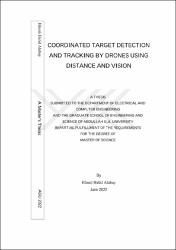| dc.contributor.author | Alabay, Hüsnü Halid | |
| dc.date.accessioned | 2022-12-16T06:29:07Z | |
| dc.date.available | 2022-12-16T06:29:07Z | |
| dc.date.issued | 2022 | en_US |
| dc.date.submitted | 2022-06 | |
| dc.identifier.uri | https://hdl.handle.net/20.500.12573/1422 | |
| dc.description.abstract | Robot autonomy refers to the ability to carry out objectives by perceiving the environment
and deciding on the actions required without human interruption. Although autonomous
aerial robots offer big advantages in our daily life, online localization and control remain
the biggest challenge lying ahead of aerial robot implementations. For single robot
applications, GPS, and motion capture (mocap) systems can be utilized for outdoor and
indoor applications, respectively. However, when it comes to multi-robot systems, the
relative localization problem needs to be solved beyond the single robot localization
problem. Furthermore, GPS signals are not available everywhere, and mocap systems
limit the application space of multi-robot systems. Motivated by the industrial application
scenarios, we address the relative localization and docking problem in multi-drone
systems where drones do not utilize any external infrastructure for localization. We
consider a two-drone system that aims at docking a target object which consists of an
ultrawideband (UWB) distance sensor. The drones are equipped with UWB sensors and
cameras and try to localize the target object and dock around it in a pre-defined
configuration in the absence of GPS and magnetometer sensors and external
infrastructures. We design an extended Kalman filter based on the dynamic model of the
drone-target configuration that fuses the distance and vision sensor outputs. Particularly,
we use the YOLO algorithm for the bearing detection between the drones and the target.
Next, we devise and implement a switching-based distributed formation control algorithm
and integrate it into the estimation algorithm. We demonstrate the performance of our
algorithm in several simulation studies in a realistic Gazebo environment. Finally, we
provide primary experimental results and a roadmap to the full implementation of the
system. | en_US |
| dc.description.abstract | Robot otonomisi, çevreyi algılayarak hedefleri gerçekleştirme ve insan müdahalesi
olmadan gerekli eylemlere karar verme yeteneğini ifade eder. Otonom hava robotları
günlük hayatımızda büyük avantajlar sunsa da çevrimiçi yer tespiti ve kontrol, hava
robotu uygulamalarının önündeki en büyük zorluk olmaya devam etmektedir. Tek robot
uygulamaları için, GPS ve hareket yakalama (mocap) sistemleri, sırasıyla dış mekân ve
iç mekân uygulamaları için kullanılabilir. Ancak çok robotlu sistemler söz konusu
olduğunda, göreli lokalizasyon probleminin tek robot lokalizasyon probleminin ötesinde
çözülmesi gerekmektedir. Ayrıca, GPS sinyalleri her yerde mevcut değildir ve mocap
sistemleri, çoklu robot sistemlerinin uygulama alanını sınırlar. Endüstriyel uygulama
senaryolarından motive alarak, drone'ların yerelleştirme için herhangi bir harici altyapı
kullanmadığı çoklu drone sistemlerinde göreceli lokalizasyon ve yerleştirme problemini
ele alıyoruz. Ultra geniş bant (UWB) mesafe sensöründen oluşan bir hedef nesneye
kenetlemeyi amaçlayan iki dronlu bir sistem düşünüyoruz. İHA'lar UWB sensörleri ve
kameraları ile donatılmış olup, GPS, manyetometre sensörleri ve harici altyapıların
yokluğunda hedef nesneyi lokalize etmeye ve önceden tanımlanmış bir konfigürasyonda
etrafına kenetlenmeye çalışırlar. Mesafe ve görüş sensörü sonuçlarını birleştiren dronehedef konfigürasyonunun dinamik modeline dayalı genişletilmiş bir Kalman filtresi
tasarlıyoruz. Özellikle insansız hava araçları ile hedef arasındaki açı tespiti için YOLO
algoritmasını kullanıyoruz. Ardından, anahtarlama tabanlı bir dağıtılmış formasyon
kontrol algoritması tasarlayıp uyguluyor ve bunu tahmin algoritmasına entegre ediyoruz.
Algoritmamızın performansını gerçekçi bir Gazebo ortamında çeşitli simülasyon
çalışmaları üzerinde gösteriyoruz. Son olarak, sistemin tam olarak uygulanması için
birincil deneysel sonuçlar ve bir yol haritası sunuyoruz. | en_US |
| dc.description.tableofcontents | TABLE OF CONTENTS
INTRODUCTION............................................................................................................................... 1
1.1 RELATED WORKS..................................................................................................... 2
1.2 ORGANIZATION ........................................................................................................ 7
SYSTEM DEFINITION................................................................................................. 8
2.1 DRONE TEAM MODEL .............................................................................................. 8
2.1.1 Drone Model.................................................................................................... 8
2.1.2 Kinematic Model.............................................................................................. 9
2.1.3 Dynamic Model.............................................................................................. 10
2.2 PROBLEM FORMULATION....................................................................................... 11
INDOOR NAVIGATION............................................................................................................... 16
3.1 GENERAL FRAMEWORK ......................................................................................... 16
3.2 LOCALIZATION ALGORITHM .................................................................................. 17
3.3 CONTROL ALGORITHM........................................................................................... 22
SSIMULATION............................................................................................................ 26
4.1 SIMULATION ENVIRONMENT ......................................................................................... 26
4.2 FORMATION MODEL............................................................................................... 29
4.3 OBJECT DETECTION ............................................................................................... 30
4.4 SIMULATION RESULTS ........................................................................................... 32
4.5 ANALYSIS .............................................................................................................. 32
EEXPERIMENT........................................................................................................... 41
5.1 EXPERIMENT SETUP ............................................................................................... 41
CCONCLUSIONS AND FUTURE PROSPECTS ............................................................... 47
6.1 CONCLUSIONS ........................................................................................................ 47
6.2 SOCIAL IMPACT AND CONTRIBUTION TO GLOBAL SUSTAINABILITY ...................... 48
6.3 FUTURE PROSPECT................................................................................................. 49 | en_US |
| dc.language.iso | eng | en_US |
| dc.publisher | Abdullah Gül Üniversitesi, Fen Bilimleri Enstitüsü | en_US |
| dc.rights | info:eu-repo/semantics/openAccess | en_US |
| dc.subject | Multi-drone systems | en_US |
| dc.subject | Image processing | en_US |
| dc.subject | Estimation algorithms | en_US |
| dc.subject | Docking | en_US |
| dc.title | Coordinated target detection and tracking by drones using distance and vision | en_US |
| dc.title.alternative | Mesafe ve görüntü kullanan dronlar ile koordine hedef teşhisi ve takibi | en_US |
| dc.type | masterThesis | en_US |
| dc.contributor.department | AGÜ, Fen Bilimleri Enstitüsü, Elektrik ve Bilgisayar Mühendisliği Ana Bilim Dalı | en_US |
| dc.relation.publicationcategory | Tez | en_US |


















